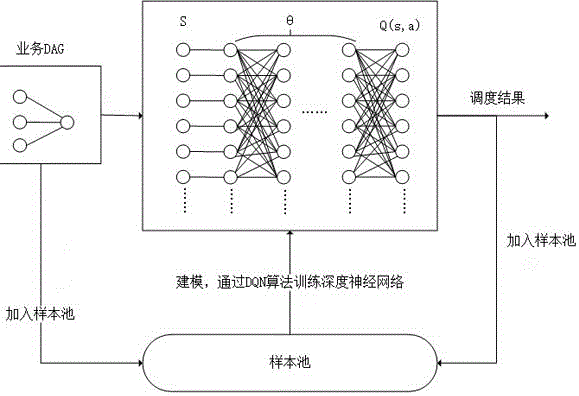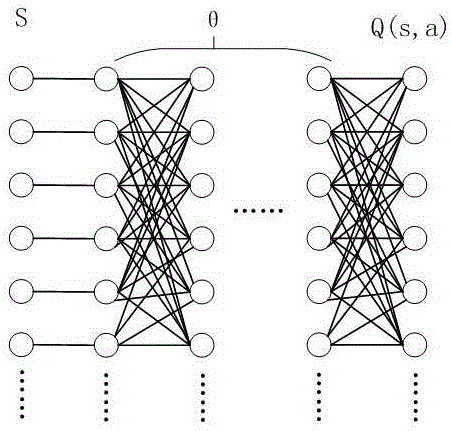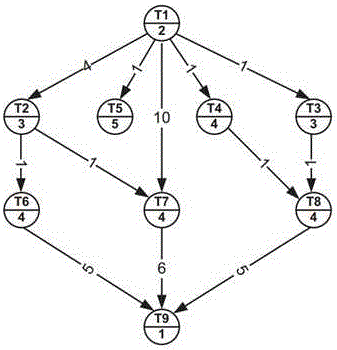Workflow scheduling method based on depth enhancement learning
A technology that enhances learning and scheduling methods, applied in neural learning methods, biological neural network models, instruments, etc., can solve the problems of increasing algorithm generalization performance, long execution time, and poor generalization, so as to increase generalization performance and ensure The effect of time efficiency
- Summary
- Abstract
- Description
- Claims
- Application Information
AI Technical Summary
Problems solved by technology
Method used
Image
Examples
Embodiment 1
[0037] like Figure 1-3 As shown, the present invention includes a workflow scheduling method based on deep reinforcement learning, comprising the following steps:
[0038] Step A) collect task execution DAG workflow directed acyclic graph M pieces in the actual execution environment as a sample pool;
[0039] Step B) Carry out MDP Markov decision process modeling on each DAG workflow directed acyclic graph, and generate task state set S;
[0040] Step C) According to the neural network training method DQN, the task state set S and the corresponding known action set A generated by M pieces of DAG workflow directed acyclic graph are used as input, and substituted into the deep neural network formula Q(s, a; θ i ), to obtain the neural network parameter matrix θ when performing task i i , Q is the action value function, s is one of the task state set S, a is a scheduling scheme in the action set A;
[0041] Step D) Determine whether the task state set S generated by the DAG ...
Embodiment 2
[0084] This embodiment is preferably as follows on the basis of Embodiment 1: it also includes step F) after the sample pool has accumulated to a certain extent, repeat step C) to the deep neural network formula Q (s, a; θ i ) to recalculate to get a new θ i value and the new deep neural network Q(s,a; θ i ) is used for DAG workflow DAG scheduling calculation of subsequent input.
[0085] When the sample pool has accumulated to a certain extent, it means that the number of DAG workflow DAG samples accumulated in the sample pool exceeds 100, and step C) is started once for calculation, and the training samples will randomly sample 100 DAG work from the sample pool Stream DAGs for computation.
[0086] With the continuous increase of DAG workflow directed acyclic graph in the sample pool, the neural network training method DQN is used to continuously update θ i value, and then calculate the optimal scheduling scheme, so that the scheduling machine can learn the scheduling str...
PUM
 Login to View More
Login to View More Abstract
Description
Claims
Application Information
 Login to View More
Login to View More - R&D
- Intellectual Property
- Life Sciences
- Materials
- Tech Scout
- Unparalleled Data Quality
- Higher Quality Content
- 60% Fewer Hallucinations
Browse by: Latest US Patents, China's latest patents, Technical Efficacy Thesaurus, Application Domain, Technology Topic, Popular Technical Reports.
© 2025 PatSnap. All rights reserved.Legal|Privacy policy|Modern Slavery Act Transparency Statement|Sitemap|About US| Contact US: help@patsnap.com



